Maintainer
** Chief WITCH **
Someone on another thread mentioned konnyaku, and I've never heard of it, so I googled it and found this fascinating site. Both konnyaku and shirataki are fine on Dukan. I'm guessing konnyaku is available in Japanese specialty stores or online like shirataki or konjac "noodles".
Konnyaku and shirataki FAQ: The almost zero-calorie, weird wobbly food from Japan
posted on 3 Jun 2009 by maki :: 57 comments
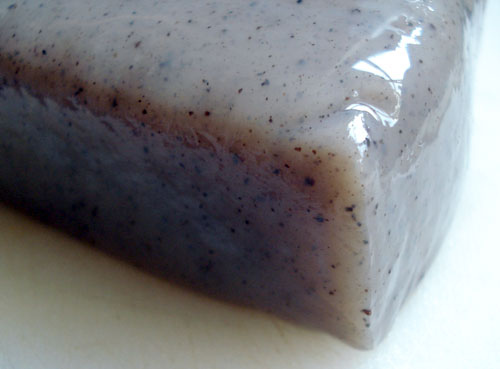
From the archives. For some reason I've been getting several email questions about konnyaku recently, so here is my definitive (I hope) guide to preparing konnyaku and konnyaku noodles, or shirataki, with a small update. Originally published in January 2007.
The quintessential Japanese foods that (may) help you lose weight, are konnyaku and shirataki. Both are made from the same substance, the corm of the konnyaku or konjac plant, also known as the Devil's Tongue plant. Shirataki is also known as konnyaku noodles, to further confuse things, but I prefer to call it shirataki, which means "white waterfall". It's basically konnyaku shaped like long thin noodles.
Konnyaku is about as close to a zero-calorie food as you can get. No wonder, since it's about 97% water. The remaining 3% is mostly fiber in the form of a viscous substance called glucomannan, plus some traces of protein, starch and minerals like calcium. It's the glucomannan that makes it so interesting as a weight loss food though. A big block of konnyaku has about 10 calories, but it's very filling. It's long been called a 'broom for the stomach' (胃のほうき) in Japan because of that.
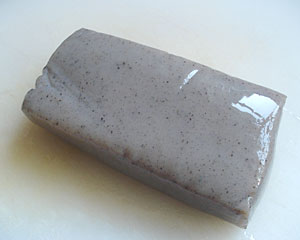 While there are several kinds of konnyaku available in Japan, outside of Japan we can usually only get ita konnyaku, basic slabs of konnyaku. Some konnyaku are white and translucent, and some are grey. Transclucent/white konnyaku is plain konnyaku made from dessicated konnyaku powder, while the grey kind is usually grey because of the addition of a powdered seaweed called arame.
While there are several kinds of konnyaku available in Japan, outside of Japan we can usually only get ita konnyaku, basic slabs of konnyaku. Some konnyaku are white and translucent, and some are grey. Transclucent/white konnyaku is plain konnyaku made from dessicated konnyaku powder, while the grey kind is usually grey because of the addition of a powdered seaweed called arame.
True konnyaku made from raw ground up konnyaku corms, called nama-konnyaku (raw konnyaku), is actually quite grey, and the seaweed-added grey industrial konnyaku is meant to look like that. (It's still made in some areas of Saitama prefecture and other places. My mother is from Saitama and I remember those grey, rather rough konnayku showing up a lot for dinner at my grandmother's house.) Other types of konnyaku mostly seen just in Japan include sashimi konnyaku, which is konnyaku with various flavorful additives in it like powdered nori or citrus skin (mostly yuzu, but other citrus too), ito konnyaku, thick noodle-shaped konnyaku similar to shirataki but slightly thicker, and tama konnyaku, ball-shaped konnyaku. This Japanese page on a konnyaku manufacturer's site has pictures of these.
There is very little difference in flavor or texture between industrial white and grey konnyaku, so it's mostly a matter of aesthetics. I like the grey kind myself, but that's probably because I grew up eating the real grey kind.
Konnyaku itself has very little flavor. It's the texture that will either be interesting or completely off-putting to the eater. It's gelatinous and firm, rather like agar-agar (kanten) but firmer and a bit rubbery. Since it has little flavor of its own, and because it's almost all water, it takes on the flavor of whatever it's cooked in. So, if the texture is okay for you you can add it to all kinds of food for the added almost-no-calorie bulk to fill up those spaces in your belly.
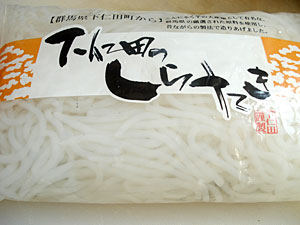 Shirataki has been getting some attention in the U.S. recently because it's noodle-shaped, and there seems to be this obsession with finding noodle and pasta-shaped food that isn't so high in calories and carbs as the real thing, like spaghetti squash strands (which are nothing like pasta either). A lot of people are disappointed when they actually try the shirataki because the texture is nothing like pasta and noodles made from flour. But again - it's a matter of getting used to it perhaps.
Shirataki has been getting some attention in the U.S. recently because it's noodle-shaped, and there seems to be this obsession with finding noodle and pasta-shaped food that isn't so high in calories and carbs as the real thing, like spaghetti squash strands (which are nothing like pasta either). A lot of people are disappointed when they actually try the shirataki because the texture is nothing like pasta and noodles made from flour. But again - it's a matter of getting used to it perhaps.
[Edit:]Note that there is something called "Tofu Shirataki" or "Noodle Tofu" sold by House Foods America - this is made from tofu and konnyaku yam. It's a little bit higher in calories. They're not the shirataki I'm talking about here, which are called "Yam Shirataki" or "Yam Noodles" - these say they have 5 calories or so per 100g. "Tofu Shirataki" is not very traditional, but shirataki has been around for centuries. You can however use "Tofu Shirataki" in most recipes that call for plain shirataki.
I happen to like konnyaku better than shirataki, because shirataki is often so thin that it's almost not there. Konnyaku is substantial enough to get your teeth into.
More recent konnyaku innovations include sweet konnyaku jellies, chewy gummy-like konnyaku chips, and grain shaped konnyaku to mix in with rice so that you are fooled into thinking you're eating rice while taking in less calores.
How to prepare konnyaku and shirataki for cooking
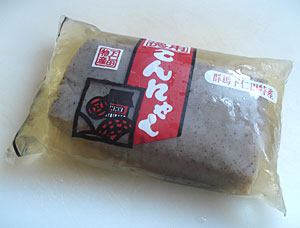 Both konnyaku and shirataki come packed in water - no wonder, since they are mostly water anyway. Open the package in a bowl or over the sink. The water will smell a odd; drain it all away. Drain away the liquid in the bag, rinse the konnyaku or shirataki briefly under cold running water, then blanch in boiling water for a few minutes, or until the water comes up to a boil, and drain well before using. This step cannot be missed, or that 'odd' flavor will linger on your konnyaku or shirataki! If you can let the konnyaku or shirataki sit for a while to dry out more, it will taste better. (Update: another konnyaku recipe with a slightly different method for prepping the konnyaku.)
Both konnyaku and shirataki come packed in water - no wonder, since they are mostly water anyway. Open the package in a bowl or over the sink. The water will smell a odd; drain it all away. Drain away the liquid in the bag, rinse the konnyaku or shirataki briefly under cold running water, then blanch in boiling water for a few minutes, or until the water comes up to a boil, and drain well before using. This step cannot be missed, or that 'odd' flavor will linger on your konnyaku or shirataki! If you can let the konnyaku or shirataki sit for a while to dry out more, it will taste better. (Update: another konnyaku recipe with a slightly different method for prepping the konnyaku.)
Shirataki may need to be cut up into manageable lengths. Konnyaku can either be cut up into cubes or slices, or torn apart into rough chunks with your hands. The torn chunks are good for putting into soups or stews, since the rough surfaces help to absorb more flavor. For stir-frying, sautéeing and such the cubes or chunks allow for more surface to be in contact with the hot pan.
The longer konnyaku cooks, the more it takes on flavors. It's really like a sponge in that sense.
The easiest way to try konnyaku is to put some small pieces into a well flavored soup or stew. Putting some chunks into miso soup is a good place to start - just be sure to cook the konnyaku in the dashi stock for a while, so the flavors can penetrate. Traditionally shirataki is put into sukiyaki and mizutaki, both of which are flavorful sort of stews. It's also put into small bags made from fried tofu (aburaage) which are put into an oden, another kind of stew with lots of fish cakes, root vegetables and so on in it.
Some caveats
Since konnyaku is almost zero-calorie, high fiber and very filling. But since it has no significant nutrients other than fiber, be sure not to overuse it. A well known Japanese journalist and writer in the 1960s called Soichi Ohyake was rumored to have died of malnutrition after attempting to lose weight by eating excessive amounts of konnyaku!
If you're serving konnyaku to kids (if they'll eat it...) make sure that the pieces are small enough, and that they chew it well, before attempting to swallow. This was a problem a few years ago with sweet konnyaku jellies that could get stuck in the throat - since konnyaku is so glutinous it was considered to be a choking hazard. (Konnyaku jellies nowadays are manufactured in smaller or different shapes to avoid this, but they have been banned in the United States and Canada.)
Recipe: Stir-fried konnyaku with tuna and garlic chives
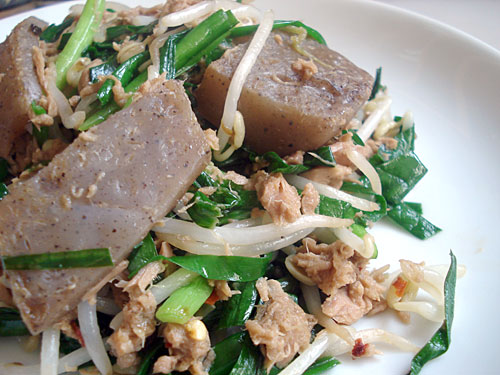
I rather like konnyaku that's been stir-fried or sautéed. Here I have used a can of tuna instead of bonito flakes, which I might use normally, but you can use any kind of flavorful protein instead (ground beef may be good..) The garlic chives (nira), which are available at Asian groceries, add a lot of flavor too.
This whole thing is about 400 calories in total, very low-carb, and yields at least 4 servings. It's very filling indeed, and a great one-dish lunch.
Preheat a wok. Once it's very hot add the konnyaku to the dry pan. It will make squeaky noises as it dries up on the surface. Add about 2 tablespoons of soy sauce, and half the butter and sesame oil, and sauté until the pieces are a bit brown on the ouside and the liquids are absorbed.
Add the red pepper flakes (as little or as much as you like), and the rest of the butter and sesame oil. Add the tuna, then add the vegetables. Stir fry until the vegetables are done. Season with salt, pepper and a bit more soy sauce to your taste.
Konnyaku and shirataki FAQ: The almost zero-calorie, weird wobbly food from Japan | Just Hungry
Konnyaku and shirataki FAQ: The almost zero-calorie, weird wobbly food from Japan
posted on 3 Jun 2009 by maki :: 57 comments

From the archives. For some reason I've been getting several email questions about konnyaku recently, so here is my definitive (I hope) guide to preparing konnyaku and konnyaku noodles, or shirataki, with a small update. Originally published in January 2007.
The quintessential Japanese foods that (may) help you lose weight, are konnyaku and shirataki. Both are made from the same substance, the corm of the konnyaku or konjac plant, also known as the Devil's Tongue plant. Shirataki is also known as konnyaku noodles, to further confuse things, but I prefer to call it shirataki, which means "white waterfall". It's basically konnyaku shaped like long thin noodles.
Konnyaku is about as close to a zero-calorie food as you can get. No wonder, since it's about 97% water. The remaining 3% is mostly fiber in the form of a viscous substance called glucomannan, plus some traces of protein, starch and minerals like calcium. It's the glucomannan that makes it so interesting as a weight loss food though. A big block of konnyaku has about 10 calories, but it's very filling. It's long been called a 'broom for the stomach' (胃のほうき) in Japan because of that.

True konnyaku made from raw ground up konnyaku corms, called nama-konnyaku (raw konnyaku), is actually quite grey, and the seaweed-added grey industrial konnyaku is meant to look like that. (It's still made in some areas of Saitama prefecture and other places. My mother is from Saitama and I remember those grey, rather rough konnayku showing up a lot for dinner at my grandmother's house.) Other types of konnyaku mostly seen just in Japan include sashimi konnyaku, which is konnyaku with various flavorful additives in it like powdered nori or citrus skin (mostly yuzu, but other citrus too), ito konnyaku, thick noodle-shaped konnyaku similar to shirataki but slightly thicker, and tama konnyaku, ball-shaped konnyaku. This Japanese page on a konnyaku manufacturer's site has pictures of these.
There is very little difference in flavor or texture between industrial white and grey konnyaku, so it's mostly a matter of aesthetics. I like the grey kind myself, but that's probably because I grew up eating the real grey kind.
Konnyaku itself has very little flavor. It's the texture that will either be interesting or completely off-putting to the eater. It's gelatinous and firm, rather like agar-agar (kanten) but firmer and a bit rubbery. Since it has little flavor of its own, and because it's almost all water, it takes on the flavor of whatever it's cooked in. So, if the texture is okay for you you can add it to all kinds of food for the added almost-no-calorie bulk to fill up those spaces in your belly.

[Edit:]Note that there is something called "Tofu Shirataki" or "Noodle Tofu" sold by House Foods America - this is made from tofu and konnyaku yam. It's a little bit higher in calories. They're not the shirataki I'm talking about here, which are called "Yam Shirataki" or "Yam Noodles" - these say they have 5 calories or so per 100g. "Tofu Shirataki" is not very traditional, but shirataki has been around for centuries. You can however use "Tofu Shirataki" in most recipes that call for plain shirataki.
I happen to like konnyaku better than shirataki, because shirataki is often so thin that it's almost not there. Konnyaku is substantial enough to get your teeth into.
More recent konnyaku innovations include sweet konnyaku jellies, chewy gummy-like konnyaku chips, and grain shaped konnyaku to mix in with rice so that you are fooled into thinking you're eating rice while taking in less calores.
How to prepare konnyaku and shirataki for cooking

Shirataki may need to be cut up into manageable lengths. Konnyaku can either be cut up into cubes or slices, or torn apart into rough chunks with your hands. The torn chunks are good for putting into soups or stews, since the rough surfaces help to absorb more flavor. For stir-frying, sautéeing and such the cubes or chunks allow for more surface to be in contact with the hot pan.
The longer konnyaku cooks, the more it takes on flavors. It's really like a sponge in that sense.
The easiest way to try konnyaku is to put some small pieces into a well flavored soup or stew. Putting some chunks into miso soup is a good place to start - just be sure to cook the konnyaku in the dashi stock for a while, so the flavors can penetrate. Traditionally shirataki is put into sukiyaki and mizutaki, both of which are flavorful sort of stews. It's also put into small bags made from fried tofu (aburaage) which are put into an oden, another kind of stew with lots of fish cakes, root vegetables and so on in it.
Some caveats
Since konnyaku is almost zero-calorie, high fiber and very filling. But since it has no significant nutrients other than fiber, be sure not to overuse it. A well known Japanese journalist and writer in the 1960s called Soichi Ohyake was rumored to have died of malnutrition after attempting to lose weight by eating excessive amounts of konnyaku!
If you're serving konnyaku to kids (if they'll eat it...) make sure that the pieces are small enough, and that they chew it well, before attempting to swallow. This was a problem a few years ago with sweet konnyaku jellies that could get stuck in the throat - since konnyaku is so glutinous it was considered to be a choking hazard. (Konnyaku jellies nowadays are manufactured in smaller or different shapes to avoid this, but they have been banned in the United States and Canada.)
Recipe: Stir-fried konnyaku with tuna and garlic chives

I rather like konnyaku that's been stir-fried or sautéed. Here I have used a can of tuna instead of bonito flakes, which I might use normally, but you can use any kind of flavorful protein instead (ground beef may be good..) The garlic chives (nira), which are available at Asian groceries, add a lot of flavor too.
This whole thing is about 400 calories in total, very low-carb, and yields at least 4 servings. It's very filling indeed, and a great one-dish lunch.
- 1 1lb or 450g pack of grey or white konnyaku, pre-prepared following the directions above
- 1 Tbs. butter (NOT FOR US)
- 1 Tbs. dark sesame oil (NOT FOR US)
- 1 small can of water-packed tuna
- 1 large bunch of garlic chives (nira), or substitute green onions and add a couple of cloves of garlic
- About 2 cups of bean sprouts
- Dried red pepper flakes
- Soy sauce (TOLERATED... use sparingly)
- Salt and pepper
Preheat a wok. Once it's very hot add the konnyaku to the dry pan. It will make squeaky noises as it dries up on the surface. Add about 2 tablespoons of soy sauce, and half the butter and sesame oil, and sauté until the pieces are a bit brown on the ouside and the liquids are absorbed.
Add the red pepper flakes (as little or as much as you like), and the rest of the butter and sesame oil. Add the tuna, then add the vegetables. Stir fry until the vegetables are done. Season with salt, pepper and a bit more soy sauce to your taste.
Konnyaku and shirataki FAQ: The almost zero-calorie, weird wobbly food from Japan | Just Hungry

